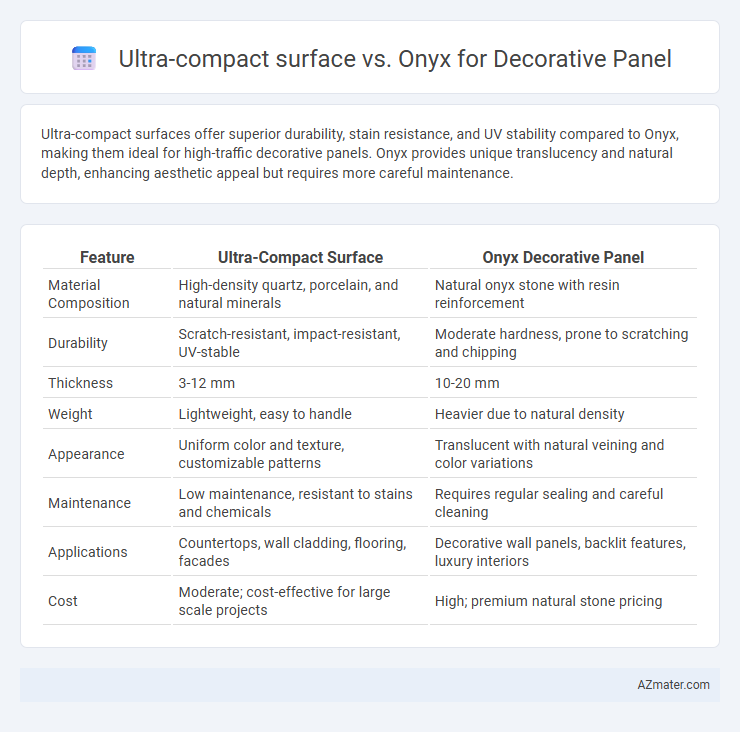Ultra-compact surfaces offer superior durability, stain resistance, and UV stability compared to Onyx, making them ideal for high-traffic decorative panels. Onyx provides unique translucency and natural depth, enhancing aesthetic appeal but requires more careful maintenance.
Table of Comparison
| Feature | Ultra-Compact Surface | Onyx Decorative Panel |
|---|---|---|
| Material Composition | High-density quartz, porcelain, and natural minerals | Natural onyx stone with resin reinforcement |
| Durability | Scratch-resistant, impact-resistant, UV-stable | Moderate hardness, prone to scratching and chipping |
| Thickness | 3-12 mm | 10-20 mm |
| Weight | Lightweight, easy to handle | Heavier due to natural density |
| Appearance | Uniform color and texture, customizable patterns | Translucent with natural veining and color variations |
| Maintenance | Low maintenance, resistant to stains and chemicals | Requires regular sealing and careful cleaning |
| Applications | Countertops, wall cladding, flooring, facades | Decorative wall panels, backlit features, luxury interiors |
| Cost | Moderate; cost-effective for large scale projects | High; premium natural stone pricing |
Introduction to Decorative Panels: Ultra-Compact Surface vs Onyx
Ultra-compact surfaces are engineered from a blend of natural minerals and porcelain, offering exceptional durability, resistance to scratches, heat, and stains, making them ideal for high-traffic decorative panels. Onyx, known for its translucent and luxurious appearance, is a natural stone prized for its aesthetic impact but requires more maintenance and care due to its softness and porosity. Choosing between ultra-compact surfaces and onyx for decorative panels depends on balancing durability and maintenance needs with desired visual appeal.
Material Composition: Ultra-Compact vs Onyx
Ultra-compact surfaces consist of a blend of natural minerals, porcelain, and resin compounds, resulting in exceptional durability, scratch resistance, and low porosity ideal for decorative panels. Onyx, a natural stone composed primarily of calcium carbonate, offers striking translucency and unique vein patterns but is softer and more porous, requiring more maintenance. The ultra-compact material's engineered composition provides superior hardness and resilience compared to the natural, delicate structure of onyx.
Visual Appeal and Aesthetic Differences
Ultra-compact surfaces offer a sleek, uniform appearance with minimal texture variation, emphasizing modern minimalism and high durability in decorative panels. Onyx, known for its natural translucency and intricate veining, provides a luxurious and dramatic aesthetic, often enhanced by backlighting to highlight its depth and color variations. The choice between ultra-compact surfaces and onyx depends on the desired visual impact, whether a clean contemporary look or a rich, dynamic statement piece.
Durability and Strength Comparison
Ultra-compact surfaces offer superior durability and strength compared to Onyx, featuring high resistance to scratches, impact, and heat, making them ideal for high-traffic and demanding environments. Onyx, while visually striking with its translucency and unique patterns, tends to be softer and more prone to chipping and cracking under heavy use. The dense composition of ultra-compact surfaces provides enhanced structural integrity, ensuring longer-lasting performance for decorative panels subjected to daily wear and tear.
Maintenance and Cleaning Requirements
Ultra-compact surfaces offer high resistance to stains, scratches, and UV rays, making them exceptionally low-maintenance and easy to clean with mild soap and water. Onyx panels, while luxurious and aesthetically striking, require more careful handling to prevent damage from harsh chemicals and abrasive materials during cleaning. Both materials benefit from regular wiping to maintain their decorative appeal, but ultra-compact surfaces provide greater durability and straightforward upkeep in high-traffic areas.
Cost Analysis: Ultra-Compact Surface vs Onyx
Ultra-compact surfaces generally present a higher initial cost compared to Onyx due to advanced manufacturing processes and superior durability features. Onyx panels, while often less expensive, may incur additional expenses over time through maintenance and potential repairs due to their relative fragility. Long-term cost analysis favors ultra-compact surfaces for high-traffic or commercial decorative panel applications where longevity and low upkeep are prioritized.
Application Versatility in Interior Design
Ultra-compact surfaces offer superior durability and resistance to heat, scratches, and stains, making them ideal for high-traffic areas and demanding environments such as kitchen countertops, bathroom walls, and commercial spaces. Onyx panels, prized for their translucent beauty and rich veining, excel in creating striking feature walls, backlit installations, and artistic focal points that enhance luxury interiors. Both materials provide diverse application versatility, but ultra-compact surfaces combine robust performance with aesthetic flexibility, while Onyx prioritizes visual impact and elegance in interior design.
Sustainability and Environmental Impact
Ultra-compact surfaces demonstrate superior sustainability in decorative panels due to their durability, low resource consumption, and resistance to wear, reducing the need for frequent replacement and minimizing waste. Onyx panels, while visually striking, often involve more energy-intensive extraction and processing methods, contributing to a higher environmental footprint. Choosing ultra-compact surfaces supports eco-friendly construction by promoting longevity and reducing the carbon emissions linked to production and maintenance.
Installation Challenges and Considerations
Ultra-compact surfaces, such as sintered stone panels, offer superior durability and heat resistance compared to Onyx but require precise handling due to their rigidity and weight, increasing installation complexity. Onyx panels, favored for their translucency and aesthetic appeal, demand skilled installers as their fragile nature and thickness variations pose challenges during cutting and mounting. Both materials necessitate specialized tools and adhesive systems to ensure secure installation, with proper substrate preparation critical to prevent warping or cracking over time.
Choosing the Best Decorative Panel for Your Project
Ultra-compact surfaces offer exceptional durability, resistance to scratches and stains, and a sleek, uniform appearance ideal for high-traffic areas in both residential and commercial projects. Onyx panels provide a unique aesthetic with natural translucency and rich color variations, lending a luxurious, artistic touch to feature walls or accent areas. Selecting the best decorative panel depends on balancing practical needs like maintenance and durability with design goals, where ultra-compact suits functional spaces and Onyx enhances visual impact.

Infographic: Ultra-compact surface vs Onyx for Decorative Panel
 azmater.com
azmater.com